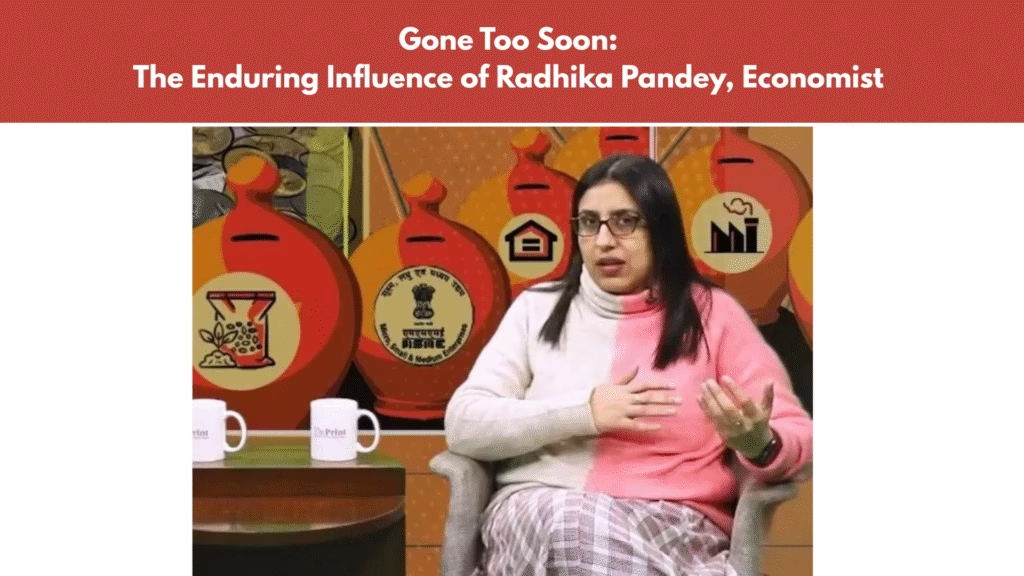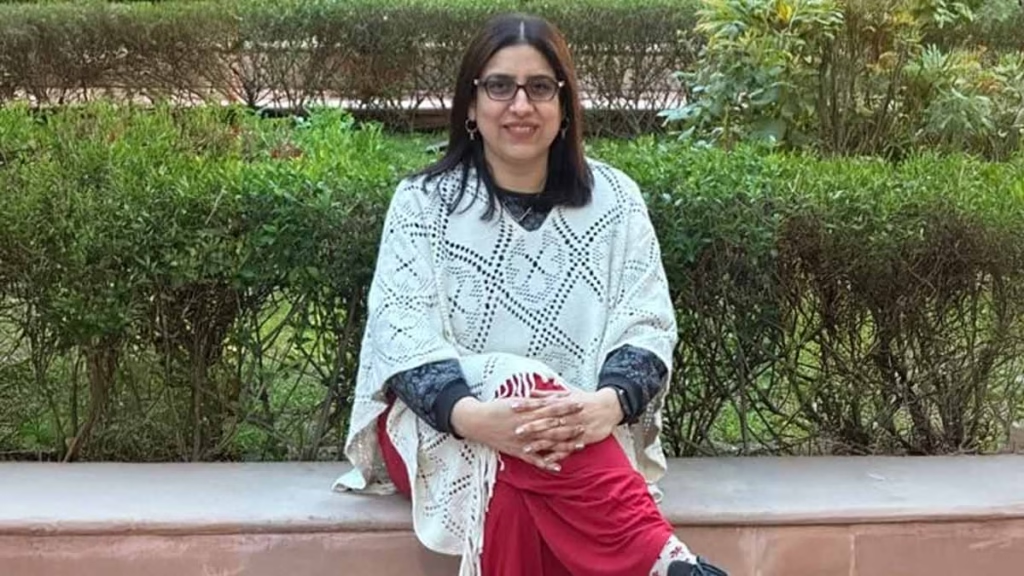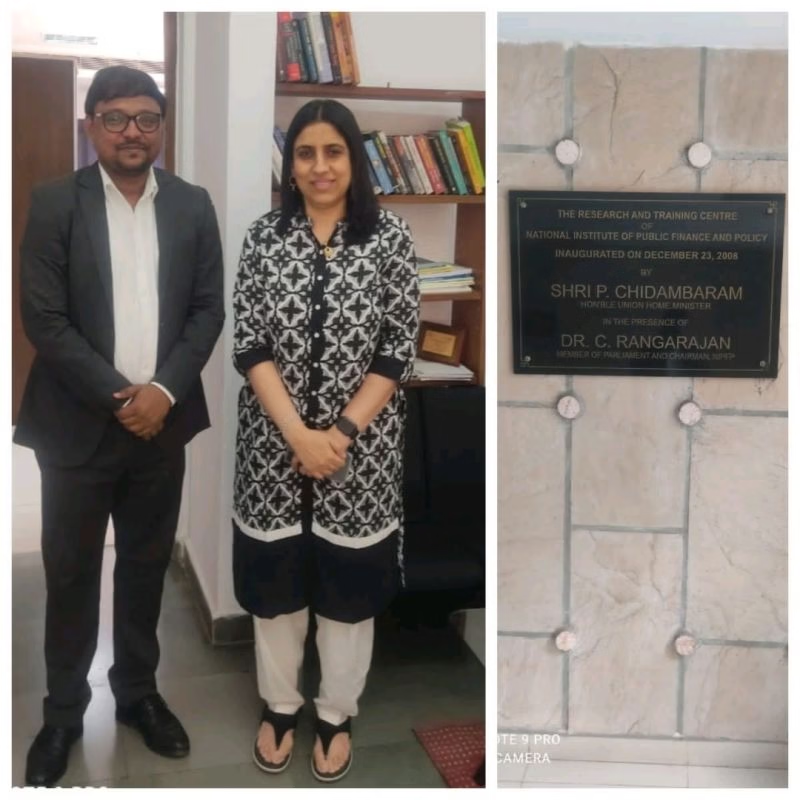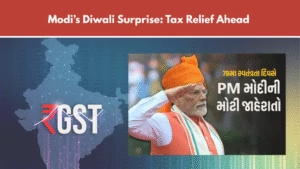Radhika Pandey: A Beacon of Modern Indian Macroeconomics – A Tribute and Analysis

Radhika Pandey
Radhika Pandey : In the realm of Indian economic thought and policy today, few voices resonated as profoundly and authentically as Radhika Pandey economist. Scholar, teacher, policy reformer, and public communicator—her career spanned over two decades, during which she shaped fiscal and financial frameworks using empirical rigour, legal insight, and public engagement. Her recent passing in late June 2025—amid an intensive battle with liver failure—left the economic community in collective shock and grief.
This blog pays tribute not only to Dr Radhika Pandey’s achievements—academic, policy-oriented, and media-facing—but also explores how her journey exemplified the synthesis of analytical depth, realignment of macroeconomic policy, and inclusive communication. It outlines her legacy and invites reflection on how her life’s work can guide future economists, especially women and public intellectuals, in shaping progressive, accessible, and systemic economic change.
1. Early Life and Academic Foundations
Born on December 18, 1978, Radhika Pandey embarked on her academic path in economics with an Honours degree from Banaras Hindu University, followed by an M.A. and Ph.D. from Jai Narain Vyas University, Jodhpur . These formative years cemented her strong analytical foundations, blending macroeconomic theory with the institutional contexts of India’s transitional economy.
Radhika Pandey – Her doctoral research focused on business cycles and household consumption dynamics—an early signal of her future passions: blending empirical methods with macroeconomic realism.

2. Blending Law and Economics: From NLU to NIPFP
Radhika Pandey began her teaching career at the National Law University, Jodhpur, where she combined economics with legal regulation—a rare and pioneering move. By 2008, she had moved to the National Institute of Public Finance and Policy (NIPFP), New Delhi, as Associate Professor . There, she blended academic rigor with a deep understanding of policy frameworks.
At NIPFP, she spearheaded quantitative economic research programs—including business-cycle dating, inflation analysis, capital flows, and legal-economic interactions—reinforcing the institute’s role as a bridge between research and policymaking.
3. Policy Engagement: From Microfoundations to National Frameworks
Pandey’s role extended far beyond academia. She influenced multiple government committees and task forces:
- Lead Coordinator, Task Force for Public Debt Management Agency (Ministry of Finance, 2014) —instrumental in modernizing India’s debt management infrastructure.
- Member, Financial Sector Legislative Reforms Commission (Justice B.N. Srikrishna, 2011) —joined efforts to overhaul India’s financial legal architecture.
- Member, Working Group on Foreign Investment chaired by U.K. Sinha —advocated for balanced foreign capital flows under macroprudential considerations.
Colleagues praised Radhika Pandey’s contributions:
“There are so many policies of the Indian government where you can see Radhika’s influence and research… She didn’t focus on just publishing papers but on the real research that goes behind actual policy making.” — Ila Patnaik
4. Radhika Pandey Core Research Areas and Contributions
a) Business Cycles & Empirical Macroeconomics
She led studies at NIPFP to identify and analyze India’s economic cycles: dating expansions and recessions, understanding determinants, and forecasting transitions—laying groundwork for economic forecasting and counter-cyclical policy.
b) Inflation Targeting
Pandey collaborated with NIPFP and IGIDR to track India’s adoption of inflation targeting by the RBI. In a 2024 research paper, she examined its transition and performance . Numerous experts credit her analysis for shaping RBI’s evolving inflation policy .
c) Financial Sector Regulation and Capital Flows
As part of the FSLRC, Pandey shaped legal and regulatory changes to banking, non-bank finance, and capital controls . Her ideas influenced frameworks governing ECBs, foreign investment, and currency controls.
d) Debt Management and Central Government Borrowing
Her leadership in the Public Debt Management Task Force (2014) had far-ranging effects on issuing government securities, risk evaluation, debt sustainability planning, and issuance calendars .
e) Sustainability & Carbon-focused Trade Policy
From 2024 onward, she worked on India’s exposure to the EU’s Carbon Border Adjustment Mechanism, pandemically aligning environmental concerns with macro-financial resilience .
5. Engaging Public Discourse: Columns and Videos
MacroSutra on ThePrint
Since 2021, Pandey authored the weekly MacroSutra column and video for ThePrint, aiming to demystify macroeconomic issues like inflation, currency volatility, or international trade shifts. Her analytical clarity and depth made policy accessible .
Ila Patnaik called her “a great communicator” who reached beyond academia . Her dedication was such that she recorded her final video from her hospital bed days before passing .
Thought Leadership Elsewhere
She contributed to Business Standard, Bloomberg, The Quint, and Ideas for India, with posts on:
- Currency volatility and rupee-dollar trends
- MSME shocks during COVID lockdowns
- EU CBAM and India’s trade positioning
Her range showed a commitment to coupling empirical insight with real-world policy demands.
6. Personal Qualities and Mentorship
Colleagues remember Pandey for warmth, dedication, and integrity.
- Business Standard’s Sudipto Mundle reflected: “Apart from her professional competence, Radhika also had strong leadership and interpersonal skills… She maintained a sound work‑life balance… evenings and weekends were reserved for the family.”
- Patnaik noted her focus on real research behind major frameworks, not just academic publications .
Her students and teams at NIPFP remember her as demanding yet supportive, empowering junior researchers and staff—a rare blend of high academic standards with personal empathy.

7. Tragic Passing and Community Response
Radhika passed away on June 28, 2025, at age 46, following acute liver failure and complications after a liver transplant . Public tributes poured in:
- Cilf of ThePrint: “It is a tremendous loss for the community, and for me personally.”
- Mundle described it as “a sad end to a struggle” .
- Decision-makers from RBI, Finance Ministry, and academic forums publicly honoured her sharp intellect and prolific voice.
The abrupt loss incited a broader reflection on institutional support for scholars in policy spaces and the fragility of talented individuals.
8. Radhika Pandey Legacy and Continuing Inspiration
a) Women in Economics
Her rise—as a woman economist at NIPFP and influential policy figure—challenges male-dominated norms. Though women make up a growing share of Ph.D. holders, representation remains low. Radhika exemplified the impact of inclusive mentoring, balanced career and family, and helped pave the path for more gender diversity in economic institutions.
b) Bridging Admin & Academia
Pandey represented the ideal: academic rigor applied to real-world reform. Her work in debt management, regulatory structures, and macroeconomic frameworks showed that deep analysis can translate into structural change.
c) Narrative Economics
Her MacroSutra writings made complex policies accessible to the public—a model for future scholars aiming to blend expert insight with civic engagement.
d) Data‑Driven Empirical Work
She emphasized measurement, seasonal correction, and rigorous cycle identification—tools that strengthen policy design and evaluation. Her publications laid methodological groundwork for Indian macroeconomic monitoring.
Conclusion: Her Enduring Impact
In the span of time that might feel fleeting to many, Dr Radhika Pandey accomplished the rare: influence across theory and real-world policy. She transformed how India manages debt, regulates finance, and applies macro-level insights to decision-making. Her willingness to speak publicly, mentor widely, and pursue intellectual rigour—combined with personal warmth—crafted a model for the modern economist.
Although gone too soon, her legacy continues:
- Students at NIPFP carry forward her empirical approaches.
- Policy frameworks she shaped now underlie RBI’s and MoF’s operations.
- Public discourse norms have been raised by the standards she set in communication.
To honor her memory, current and future economists—especially women—should continue pushing the boundaries she helped create: combining empirical inquiry with policy design and clear public voice.




